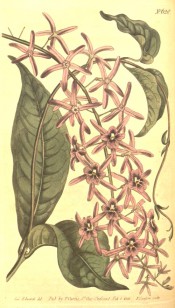Petrea volubilis L.
Frost tender, woody-stemmed, semi-evergreen climber with branching, twining stems, elliptic leaves, to 20cm long, and panicles, to 35cm long, of small, salverform, violet flowers with lilac calyx lobes, from late winter to summer. To 12m. [RHSE].
Horticultural & Botanical History
‘Houstoun first discovered this plant at Vera Cruz in New Spain, and named it in honour of the then Lord Petre, who was much attached to Botany, but unfortunately died of the small-pox when a very young man, having in his life-time erected the most magnificent conservatory then existing in Europe. There appears to be two varieties of this shrub, one with white, the other with violet-coloured corollas, but the calyx in both is blue; ours is the precise variety described by Jacquin, who found it in Martinique, where he says it ascends to the top of trees twenty feet high. The corolla, which Is five-cleft and subbilabiate, is of very short duration, but as the calyx is a conspicuous part of the flower, the long racemes hanging pendent from the extremities of the branches make a handsome appearnce for some time. It has been suspected that the male and female flowers are distinct; as only one bunch was produced we cannot decide the question, but the pistils appeared to us to be either totally wanting or very imperfect. It is a very ornamental shrub, requires to be kept constantly in the stove, and might be advantageously planted in a box in the corner of the tan-pit and trained to the rafts or to a trellis, thrives best in a rich loam and loves warm moist air. Imported by Mr. Woodford from from St. Vincent’s, in whose stove at Vauxhall it flowered, as we believe, for the first time in this country, in August last: in the West-Indies its blossoms are produced in November.’ [BM t.628/1803].
‘It is a very beautiful climber. […] With us it grows to ten or twelve feet in height, with proper support, and produces its elegant pendulous blossoms in succession during the greater part of the year.’ [LBC no.736/1823]. Introduced to Britain in 1733. [JD]. BR f.1678/1834.
History at Camden Park
Desideratum to Loddiges Nursery, 6th January 1845 [MP A2933-2, p.28]. This is the first record and is a likely source although it first appears in the catalogues in 1857 [T.741/1857].
Notes
Petrea volubilis Vell. (1829) = P. subserrata Cham.
Petrea volubilis Gaertn. (1791) = Patagonula americana L.
Petrea volubilis Walp. (1843) = P. arborea H.B. and K.
Published Feb 16, 2010 - 09:07 PM | Last updated Aug 01, 2010 - 03:11 PM
| Family | Verbenaceae |
|---|---|
| Category | |
| Region of origin | Central America |
| Synonyms | |
| Common Name | Sand paper, Purple wreath, Queen’s wreath |
| Name in the Camden Park Record |
Petrea volubilis |
| Confidence level | high |


